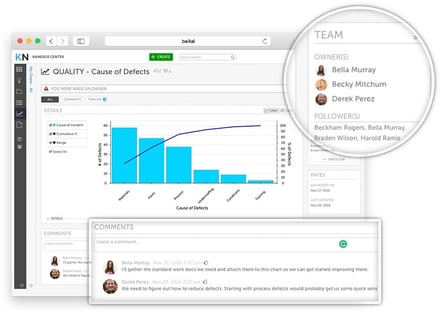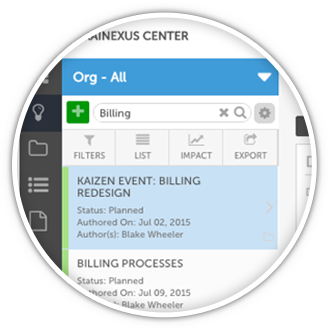 Although it got its start in the auto manufacturing industry, the Lean management approach to business is now widely used in every industry. It is particularly popular in healthcare, construction, and higher education. The Lean methodology and its cousins, Six Sigma, TQM, and others, are popular because they bring order to the essential responsibility of every organization to continually improve operations and results.
Although it got its start in the auto manufacturing industry, the Lean management approach to business is now widely used in every industry. It is particularly popular in healthcare, construction, and higher education. The Lean methodology and its cousins, Six Sigma, TQM, and others, are popular because they bring order to the essential responsibility of every organization to continually improve operations and results.
While it is certainly possible to implement Lean or another organized management approach without software, many organizations find that a Lean management system is essential to rapid and long-lasting success. The most important features of a Lean management system include:
- A centralized platform for improvement projects
- 24x7 access from anywhere
- Workflow with automated alerts and notifications
- Robust search capabilities
- Built-in collaboration tools
- Advanced reporting and analytics
- Improvement impact measurement
- Success broadcasting
- Data visualization and dashboards
These features make Lean management systems much more effective for managing improvement work than spreadsheets and email. Here are the top ten benefits they provide for organizations that implement the software successfully.
 1 – Everyone has one source for information
1 – Everyone has one source for information
Email is great as a platform for reminders, but it is terrible as a source of truth. Spreadsheets are also great for making lists, but they are a passive and easily corrupted data collection method. Lean management systems, on the other hand, give everyone one on the team one always-up-to-date source for information and assignments. Everyone is on the same page because they are looking at the same information, not some email message or file that may have made it to some people, but not all. The Lean management software creates the ballpark, if you will, where the game of improvement will be played.
2 – It is available 24 x 7 from anywhere
Many of the tools that were originally used in Lean involve physical artifacts that exist within the workspace. These include huddle boards, Kanban signs, and similar techniques. These tools work well for some factory work and other types of work that are tied to the location, but many of today’s workers are information workers, people who work from home, or those that utilize a distributed workforce. For these situations, a cloud-based solution that people can access from wherever they are, on whatever device they choose and whenever they want is better suited to collecting and acting upon opportunities for improvement.
 3 – Lean management systems support improvement culture
3 – Lean management systems support improvement culture
One thing we notice when an organization implements a Lean software solution is that the team quickly begins to develop a common language around improvement. People start to talk about the progress of an opportunity through the stages of execution in a way that everyone in the organization can easily understand. This shared experience speeds the progress of each project and helps cement Lean as part of how daily business is done.
4 – People take Lean more seriously
When the executive team is willing to invest in a Lean management, employees recognize the signal that this is important to the success of the organization and act on that knowledge. Implementing and supporting such a solution makes it clear that Lean isn’t just another management fad, but rather it is central to how the business will function.
5 – Active management sustains improvement
We mentioned before that spreadsheets are passive. It’s all well and good as long as someone remembers to go update the spreadsheet. They accept information, they don’t demand it. Lean management systems, on the other hand, offer alerts and notifications to ensure that forward progress on improvement projects is maintained. If milestones or task due-dates are missed, managers are alerted and can take proactive steps to keep each project on track.
 6 – Teams develop a repository of knowledge
6 – Teams develop a repository of knowledge
We think that huddle boards are a great visual management tool, but what happens when an improvement is complete, and it is removed from the board? In many cases, the lessons learned are lost or shut away in a drawer somewhere. Lean management systems, on the contrary, create a digital home that can store the experience and results of every improvement without limit. Employees can search the database to find similar projects or problems and learn from what has been done in the past.
7 – Leaders can assess the health of Lean
How many opportunities for improvement were added last month and by whom? Are there any projects that are stalled and require executive intervention? What types of improvements are being completed or neglected? Which teams deserve recognition? In what ways has Lean paid off? These are all difficult questions to answer without a centralized improvement platform in place. Lean management systems make getting this insight easy with dashboards and detailed reports.
The right technology won’t guarantee success, but a Lean management system certainly increases the odds of engagement and impact. It is a valuable asset for front-line employees, executive leadership and everyone in between.
For more information about Lean Management Systems, check out this free eBook:



Add a Comment